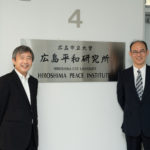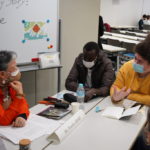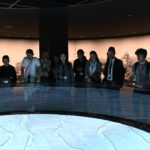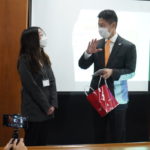I. Battles in the Mainland and Hiroshima
1. Chugoku Sokan-fu Authorities
Near the end of the Asia-Pacific War, when Japan’s defeat seemed inevitable, Japanese leaders prepared for battles on the Mainland. In April 1945, in anticipation of the projected Allied invasion of Japan’s mainland, the government established the First General Army responsible for eastern Japan (headquartered in Tokyo) and the Second General Army responsible for western Japan (headquartered in Hiroshima). Controlling the Japanese Fifteenth Area Army (headquartered in Osaka) and the Japanese Sixteenth Area Army (headquartered in Fukuoka), the Second General Army set its headquarters on the site used by the Fifth Cavalry Regiment, located in Futabanosato, Hiroshima City. In July, the Japanese 59th Army (parent unit: the Japanese Fifteenth Area Army) and Chugoku Military District were established. The Army’s Shipping Command, which handled shipping operations led by the army (united with the army transportation unit), was in Ujina, and took command of 240 army groups outside and inside of Japan, with total of more than 300,000 personnel (Akatsuki Butai). Near the end of the war, Hiroshima became a more important hub for the Japanese Army. Kure City, which is located near Hiroshima City across from Hiroshima Port, was a marine hub which had Kure Naval District, the largest naval arsenal in western Japan.
Along with the military district system, the Chugoku Sokan-fu [the locational governmental office] was established. It was delegated authorities by the central government. The Chugoku Sokan-fu, which presided over five prefectures was established in Hiroshima. Isei Otsuka, the governor of Hiroshima Prefecture as well as the head of Chugoku regional administration council, was appointed head. Locational government offices had great power. The Chugoku Sokan-fu exercised the right to command governmental offices and governors of five prefectures in the Chugoku district, and the right to request deployment troops by the army and navy. The head office was set up in Hiroshima Bunrika University, located in Senda-machi.
2. Preliminary Measures against Air Raids
Genshin Takano took over the position of Hiroshima Mayor after Otsuka left to become the head of Chugoku Sokan-fu. As the person in charge of civil air defense, and having experienced the bombing of Osaka, Takano had a sense of the danger of the delay in preliminary measures against air raids.
Currently, this city has relatively few air raids, but I am ready for possible massive air raids in the near future. As this is a small city with many rivers, most of the buildings are built of wood. In the event of a fire, we would have a difficult situation. I am alarmed and worried.
(Letter of Shingen Takano)
Although there was no way for the mayor to know that air raids on Hiroshima had been forbidden because the city was the target of atomic bombing, Takano expressed worry (“I feel uneasiness”) n a letter written on July 20 about the lack of air raids, and hastened the process of organizing an evacuation1.
Amid the situation where many medium- and small-sized cities were destroyed, our Hiroshima City has had only minor damage. I feel rather uneasy about it. I am unsure if preparations for evacuation can be completed before a possible attack, but I have implemented them on a large scale.
(Letter of Shingen Takano)
As Hiroshima was originally a military-based city, it had focused on air defense measures such as implementing air-raid drills. However, airstrikes on other cities were more massive than predicted. In addition, the fact that there had been no air raids targeting Hiroshima, despite its being a military-based city, had caused some fear. Hence, the authorities assumed that air raids on Hiroshima would be the largest yet experienced. The municipal police “predicted that Hiroshima, an important hub, would experience dreadful air raids the like of which other cities have never experienced,” and proceeded to implement measures with an “extravagant assumption” that 300 B-29 bombers would come to attack the city2. In addition, as a life-saving and medevac measure, the authorities borrowed 200,000 inner tubes from the Akatsuki Butai army and requested them to deploy their boats in each river. Furthermore, they established a support scheme in which police offices neighboring Hiroshima City provide food (rice balls for 200,000 people and dry biscuits and water for 400,000 people) without instructions in the event of air raids on Hiroshima. (Diary of Torayoshi Ishihara)
3. Air Raids Policy by Administrative Agencies
The Prefectural Office in Kako-machi was wooden structure built in 1878 with a 70,000㎡ vacant lot created after removing neighboring buildings. The office was not fire resistant. Then, the Division of Police was transferred to Hiroshima City Hall and the Division of Public Works was moved to Honkawa National School since both buildings were fire resistant. In addition, other Divisions were evacuated to Aki Women’s High School (Part of the Investigation Division and Agricultural Division), Fukuromachi National School (Sanitary Division), Hiroshima Chamber of Commerce and Industry (part of the Accounting Division), and a school for the blind in Nagaomachi (part of the Educational Affairs Division). Since the seven rivers flowing through the city would function as natural fire belts, divisions were allocated in each area’s delta in order to avoid complete destruction of administrative functions. Also, Hiroshima City Hall, Honkawa National Schools, Hiroshima Chamber of Commerce and Industry, Aki Women High School and Fukuya Division store were appointed as sites to which to transfer the Hiroshima Prefectural Office in case the office were damaged by air raids.
At the same time, “reflecting the intention of mayor Takano, 300 public servants stayed at the Prefectural Office every night in order to protect the office at all costs whatever happens,” strengthening the defense system (Kenchou Genbakuhisaishi (Chronicle of A-bomb Damage to the Prefectural Office), p177). At Hiroshima City Office, 60 officers stayed in rotation. The city employees were also responsible for evacuation guidance. Dividing the city into 24 small areas, the Boukuu Shouku Genchitai officers [evacuation guidance groups consisting of city employees] were allocated to each area to support citizens with evacuation as well as to contact the city authorities in case of air raids. (Shiyakusho Genbakushi (Chronicle of A-bomb Damage to the Hiroshima City Hall), pp16, 33). This was part of preparations for the mainland battle, and public servants were required to “with a spirit of sacrifice,” “discharge your duties and show yourself at your best in the decisive battle as governmental employees of the empire.” (Instruction by Mayor Otsuka on May 10). (Kenchou Genbakuhisaishi (Chronicle of A-bomb Damage to the Prefectural Office), p34-35).
Another important challenge was to protect public documents from air raids. Hiroshima Prefecture transferred public documents to Takada District Office (Yoshidacho, Takada District), recreation facility for teachers (Jigozenmura, Saeki District), Aki Woman’s High School and a school for the blind in Hiroshima. In addition, to documentary evidence regarding expenditures and other documents were stored in air-raid shelters near the prefectural office and these documents remained undamaged.
Hiroshima City evacuated a large part of family registration to Sanyoubuntokuden, [a hall built to commemorate a Japanese Confucianist, Rai Sanyo] in Hijiyama. The building was used by the Branch of Family Register and Election Division and employees worked there. Booklets often used such, as parts of family registration lists, seal registration, and land and house registers, were kept in the basement in front of the city hall, at the former site of the Fujita Building. Those documents also remained undamaged in the atomic bombing. However, documents of each division kept in the storage room of the Archives Section located on the north side on the third floor of the City Hall were lost in a fire when they were temporarily evacuated in Otemachi National School. These documents were scheduled to be moved to the Seinenkan building in Takata, Furutamachi, Saeki District. Other important documents stored in warehouses, which were left after building evacuation, were also destroyed by fire. (Fumiaki Kazuno)
1 Recalling the building evacuation, Director of the Police Department Torayoshi Ishihara commented that because the Hiroshima City does not face the open sea and also “the policy of the building evacuation attempted to reflect public opinion,” “there were some delays”
2 The prediction of a high possibility of massive air raids was known by all the directors of the Police Department. Tomita from the Ujina Police Station remembered that Matsumoto, the Head of Nishi Police Station, said in a meeting before the atomic bombing: “Hiroshima has not experienced bombing so far, however, there must be massive air raids in near future. In that case, the measures that we have planned would not work. I am considering “unplanned plans” (Kenchou Genbakuhisaishi (Chronice of A-bomb Damage to the Prefectural Office) pp 273-274)
Tags associated with this article








